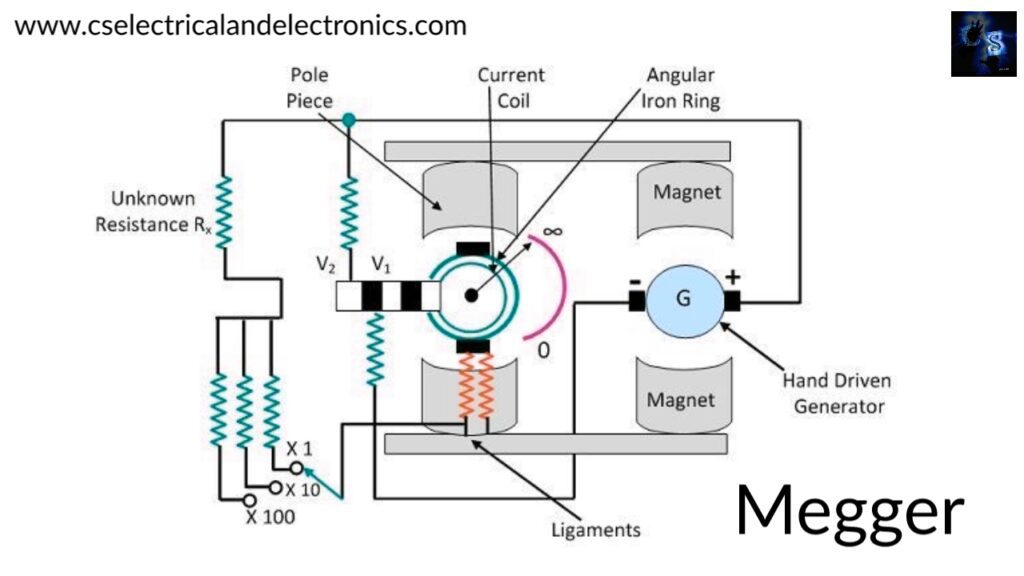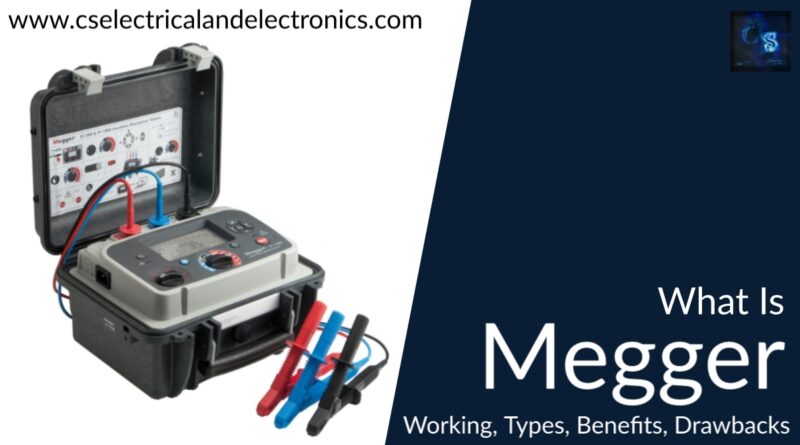What Is Megger, Working Principle, Benefits, Types, Construction
Hello guys, welcome back to my blog. In this article, I will discuss what is megger, the working of megger, its advantages, types, and construction, and we will also try to keep this article as simple as possible.
If you have any electrical, electronics, and computer science doubts, then ask questions. You can also catch me on Instagram – CS Electrical & Electronics.
Also, read:
- What Is SoC In Battery, State Of Charge, Methods, Purpose
- What Is SoE In Battery, State Of Energy, Methods, Purpose
- What Is SoF In Battery, State Of Function, Methods, Purpose
What Is Megger
The megger is a measurement instrument that is used for measuring insulation resistance and it is used for high resistance as the resistance of the insulation is very high. Insulation resistance of any electrical system may reduce with time, an environmental condition that is temperature, humidity, moisture, dust particles, etc.., so, it is necessary to check the insulation resistance at a regular interval of time, we use the megger in this purposes for measuring of insulation resistance to avoid electric shocks.
Principle of megger:-
It works on the principle of moving coil. when current is flowing in a conductor which is placed in magnetic field experiences a force or torque.
Types of megger:-
The megger is categorized into two types:-
- Electronic type(battery operated)
- Manual type(hand-operated)
Construction of megger:-

Deflecting and controlling coil:- In the merger, we have two coils they are deflecting and controlling coils which are in right angle to each other and the polarities of the torques produced by two coils are opposite in direction to each other .these two coils are connected parallel to the dc generator.
Permanent magnets:- To deflect the pointer we need a magnetic field and current flowing conductor as the current flows through the deflecting and controlling coils and the magnet field is produced by the permanent magnets with north and south poles.
Pointer:- One end of a pointer is connected to the coils and another end is connected to the deflection of the pointer on a scale from infinity to zero.
Pressure Coil Resistance and Current Coil Resistance:- The resistance of the current coil and pressure coil of the instrument protect from any damage because of low electrical equipment resistance while in the test.
Scale:- A scale is provided in the front top of the megger from the range ‘zero’ to ‘infinity’, enabling us to read the value as it may be analog or digital.
Dc generator:- For manually operated megger the testing voltage is produced by a hand-driven dc generator.
Battery connection:- For testing of insulation resistance we need some amount of testing voltage as it is in case of automatic type megger we use battery or electronic voltage charge for this purpose.
Working of megger:-
The testing voltage is required in order to test the insulation resistance of the cable, machine winding, transformer insulation test, etc. By using megger for this testing voltage we are using a hand-driven dc generator when the rotor of the hand-driven generator is rotated by the handle of a prime-mover then there exists a voltage according to the principle of dc generator.
Whenever a conductor is placed in between the varying field then there induces an electromotive force in the conductor i.e.., which is known as the voltage builds up in the conductors of dc generator by that there flows a current through the coils of deflecting and controlling coil in the anticlockwise direction to each other than in the two coils there forms a magnetic flux by flowing of current through it and the deflecting and controlling are known as the current and pressure coils.
So, when the pressure coil rotates the moving coil is in an anti-clockwise direction whereas the current coil rotates in a clockwise direction. when the unknown resistance is connected in the circuit the pointer of the moving coil becomes stable, and the pressure coil and current coil balance the pointer and sets the pointer at the deflected point i.e.., at the middle of the scale.
Applications of Megger:-
- The electrical resistance of the insulator can also be measured
- Electrical systems and components can be tested
- Winding installation.
- Testing of battery, relay, ground connection…etc
I hope this article may help you all a lot. Thank you for reading.
Also, read:
- 10 Tips To Maintain Battery For Long Life, Battery Maintainance
- 10 Tips To Save Electricity Bills, Save Money By Saving Electricity
- 100 (AI) Artificial Intelligence Applications In The Automotive Industry
- 100 + Electrical Engineering Projects For Students, Engineers
- 1000+ Control System Quiz, Top MCQ On Control System
- 1000+ Electrical Machines Quiz, Top MCQs On Electrical Machines
- 1000+ MATLAB Simulink Projects For MTech, Engineering Students
- 50 Tips To Save Electricity At Home, Shop, Industry, Office
Author Profile
- Content Writer
Latest entries
 All PostsMay 3, 2021What Is Megger, Working Principle, Benefits, Types, Construction
All PostsMay 3, 2021What Is Megger, Working Principle, Benefits, Types, Construction All PostsMay 3, 2021What is Skin Effect, Cause Of Skin Effect, Drawbacks, Avoid It
All PostsMay 3, 2021What is Skin Effect, Cause Of Skin Effect, Drawbacks, Avoid It All PostsApril 29, 2021Types Of Power Electronic Converters, Applications Of Power Converters
All PostsApril 29, 2021Types Of Power Electronic Converters, Applications Of Power Converters All PostsApril 29, 2021What Is Voltage Regulator, Working, Types, Benefits, Drawbacks
All PostsApril 29, 2021What Is Voltage Regulator, Working, Types, Benefits, Drawbacks








